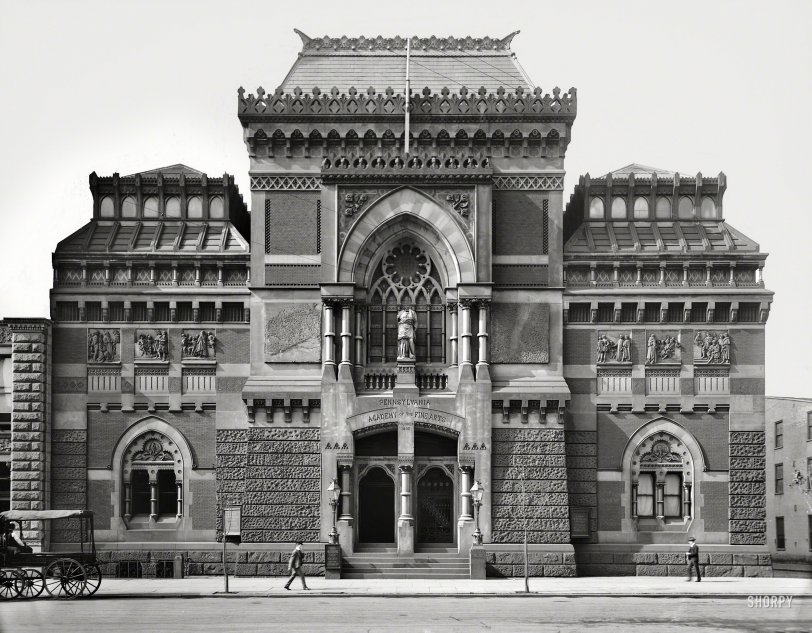


Framed or unframed, desk size to sofa size, printed by us in Arizona and Alabama since 2007. Explore now.
Shorpy is funded by you. Patreon contributors get an ad-free experience.
Learn more.

- Lofty addition
- In 1912
- Keenan Building
- Six years old
- Taken from the P.J. McArdle Roadway?
- It stood only 47 years
- Three track mind
- Incline to the right
- Reach for the sky, 1912 style
- No clean sweep
- Same Job Title, Same Face
- Sadly Lost
- Beautiful ...
- Where you get your kicks
- Aim High
- Pueblo Revival sisters
- Pueblo Neoclassicism
- Milk Man
- Regional dialect.
- Spielberg's inspiration
- Great Photo
- Loaf Story
- Do you still have the Rakes category?
- Could almost be a scene from the 1957 movie 'Hell Drivers'
- The Wages of Fear.
- Conspicuous by their absence
- Got Milk?
- All that aluminum
- No lefties
- Smoke 'em if you've got 'em
Print Emporium
PAFA: 1900

1900. "Pennsylvania Academy of the Fine Arts, Philadelphia." Who can fill us in on that headless statue? 8x10 inch dry plate glass negative. View full size.
The Architect
The man who designed the building behind the statue was Frank Furness, pronounced "furnace". After earning a Medal of Honor in Civil War, he became an architect and designed a number of buildings in a bold and unorthodox manner. The style fell out of fashion after he died, and many of his creations were demolished. Nowadays many people find them interesting and the remaining structures are being preserved. His Broad Street Station, West End Trust, and Blaine Mansion have all been featured on Shorpy, but only Blaine still stands.
The amazing though sad story of Ceres
From the PAFA web site:
In 1827, Commodore Daniel F. Patterson commanded the U.S.S. Constitution on an anti-pirating mission in the Mediterranean Sea, while quietly supporting the Greeks in their war against the Turks. Upon rescuing four near-starved Greek refugee soldiers, Patterson learned the location of a valuable marble sculpture. Indeed, the grateful soldiers offered to sell the sculpture, an 8-foot, 3rd-century BCE, full-length figure depicting Ceres, the goddess of the harvest.
Almost as an act of charity, the Commodore agreed to the purchase, and brought the headless sculpture home to Boston. Upon arrival in 1828, he wrote PAFA and offered the statue as a gift: “I regret its mutilated state and that I was unable to procure the Head tho I offered a high price.” PAFA had no qualms about accepting a headless sculpture, nor did the fact that the sculpture was effectively looted from a war zone seem to have been an issue.
While we might not expect 19th-century PAFA to adhere to 21st-century museum standards, what happened in 1937 is perhaps slightly more jarring.
The Plinth
In 1876, PAFA opened its new Furness and Hewitt-designed building. So highly thought of was the Ceres sculpture that the plinth, immediately above the front entrance, was designed specifically to house the sculpture. By 1937, the ravages of industrial air pollution and cold winters had rendered Ceres into a damaged menace to pedestrians.
City officials urged that it be removed and PAFA secured bids. To remove the piece intact would have cost “well on $1,000,” and restoration was deemed impossible. Instead, $150 was spent erecting scaffolding and $250 was given to a local sculptor, whose contract stated that “the marble will be removed in small pieces by competent workmen.”
Thus Ceres was chipped into oblivion, although her remains were given to PAFA faculty members for use in creating their own sculpture. Charles Rudy’s Pekin Drake, carved from Ceres’ marble, is on view in PAFA’s Sculpture Study Center in the Samuel M. V. Hamilton Building.
Ceres’ sad end did not escape unnoticed. TIME magazine published a brief illustrated article, and William B. Dinsmoor of Columbia University’s School of Art and Archeology was able to use the accompanying photograph to identify Ceres and the last resting place for a marble head “which Commodore Patterson fortunately did not bring back from Greece, but left at Megara, where it still exists today.”
Body gone, but still a head
The head of Ceres by the way still does exist in Megara, Greece, it was not imported in the 1820s with the rest of the statue, which suffered such an ignominious death in Philadelphia.
























On Shorpy:
Today’s Top 5